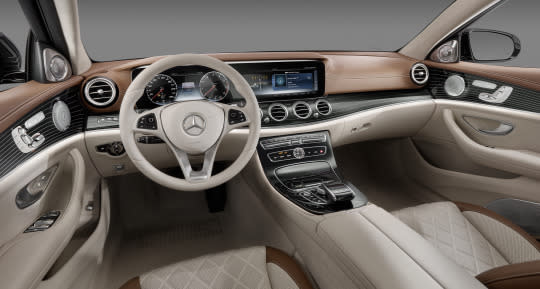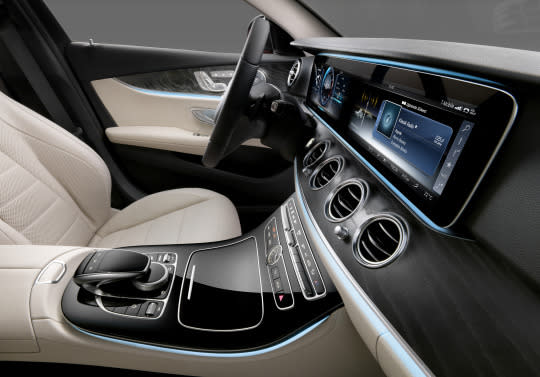Mercedes-Benz Shows Off Huge Glass Dash In Next E-Class

Automakers keep talking about our “buttonless” future–one complete with touch screens, gesture tracking and voice control. Yet up to this point, they have roundly failed at making the most basic things like simple navigation as user friendly as possible.
Mercedes is the latest to make the attempt to bring drivers into a future that features more intuitive design and interaction as well as fewer physical buttons, via a preview of the interior of the 2017 E-Class.

Mercedes-Benz has outfitted the new E-Class with a suite of new technology that includes car-to-car communications, the ability to unlock your car using your smartphone, remote parking (you can park your car in a tight space using the mobile app), and a new, optional, digital dashboard display that puts most functions under the driver’s control via touchpads on the steering wheel.
Mercedes will unveil the 2017 E-Class at the Detroit Auto Show next year, but we got a sneak preview of the interior and some of the upgraded technology that the middle child will get, in Germany last week. While the S-Class is typically the model that gets all the tech upgrades, the E-Class will be one of the most technologically advanced cars in the Mercedes line-up.
The focus of the new technology originates from what the Director of Interior Design, Hartmut Sinkwitz, calls “a desire to blend high-tech with traditional craftsmanship,” and Mercedes-Benz’s tenant of “emotional intelligence.” While it is a squishy, marketing-speak term, what Mercedes is trying to get at is a balance between easily accessible technology and control and a feeling of luxuriousness in the new E-Class.
To tackle this, Mercedes created two new work groups; the Digital Graphic & Corporate Design group, and the Digital Vehicle & Mobility group. The goal of both groups is to focus more extensively on user-experience design across all of Mercedes vehicles –whether they’re passenger cars or commercial vehicles. This group will also focus on autonomous systems like the one in the F015 we drove in April this year, and assisted driving.

In the E-Class the group worked hard on getting the interfaces just right. An optional upgrade puts the traditional dashboard and infotainment system behind one continuous piece of glass that floats in the middle of the dashboard. It gives passengers a very slick and futuristic sense as they sit in the cockpit. While it appears that the dash is one solid screen, it is in fact two 12.3-inch displays with a 1920 x 720 resolution behind one solid piece of glass. In a world where most automakers are opting to create touch screens for information input, Mercedes opted out because as one engineer told me, it’s just not very ergonomic. Using the controls on the steering wheel is intuitive enough that you don’t miss the touch pad, and the fact that you never have to take your hands from the wheel makes it that much easier.
To control the two separate screens and their individual features, you use two small square touch pads on the steering wheel. The small mouse-like pads respond to fingertip brushes and haptic clicks allowing you to scroll and select, freely. The left set of controls handle all the car information in the instrument cluster including driving modes and navigation. The right controls manage all the infotainment content. There are a few things you cannot do from the steering wheel –including activating the optional massage settings for driver and passenger or adjusting the more than 64-color lighting scheme in the car. For that Mercedes has included the familiar scroll wheel in the center console, the same one that controls Mercedes COMAND system on other automobiles in the line.
Like Audi’s virtual cockpit, you can change the look of the gauges and the information displayed in them. The settings range from Classic to Sport and Progressive. In each setting, gauges change color and font as well as layout from a traditional two dial to a single dial with two rectangles for other information. In each “tube” as Mercedes calls it (the two dial positions) you can put pretty much any information you want—including navigation, music information or fuel economy. The interface is simple enough that you shouldn’t have to take your eyes off the road to make the change and the menus that received a lot of complaints for their complexity have been greatly simplified making the experience a lot more user friendly.

New dash and interior materials include a beautiful yacht inspired wood that gets laser-etched longitudinal lines that wrap from the dash around to the doors. This particular treatment gives the E-Class a nautical feel that almost feels richer than a top of the line S-Class interior. Mercedes also offers a woven steel treatment that from a distance appears to be carbon fiber but upon closer examination a fine cloth-like pattern appears. To go along with the new dash treatments, Mercedes has also announced a new set of optional leather color combinations for the interior including their top-line Designo styling.
Mercedes will also offer the Burmester sound system in the E-Class. Complete with 23 speakers, the 1,450 watt system gets five different listening presets. The system essentially tries to recreate the room in which the recording was made by analyzing the sound. Engineers played Adele’s “Hello” on the system for us in the 3D surround setting and the effect was hugely impressive.

The effect of these optional upgrades makes the E-Class appear to be a simpler, more elegant machine than its more luxurious big brother, the S-Class. While the S-Class is generally the technological flagship in the Mercedes-Benz line-up, when it’s unveiled, the E-Class will become the most technologically advanced car in the line-up. Sadly, we’ll have to wait until next year to get a glimpse of the exterior and a chance to test the new systems.
All photos are courtesy of Mercedes-Benz

 Yahoo Autos
Yahoo Autos 